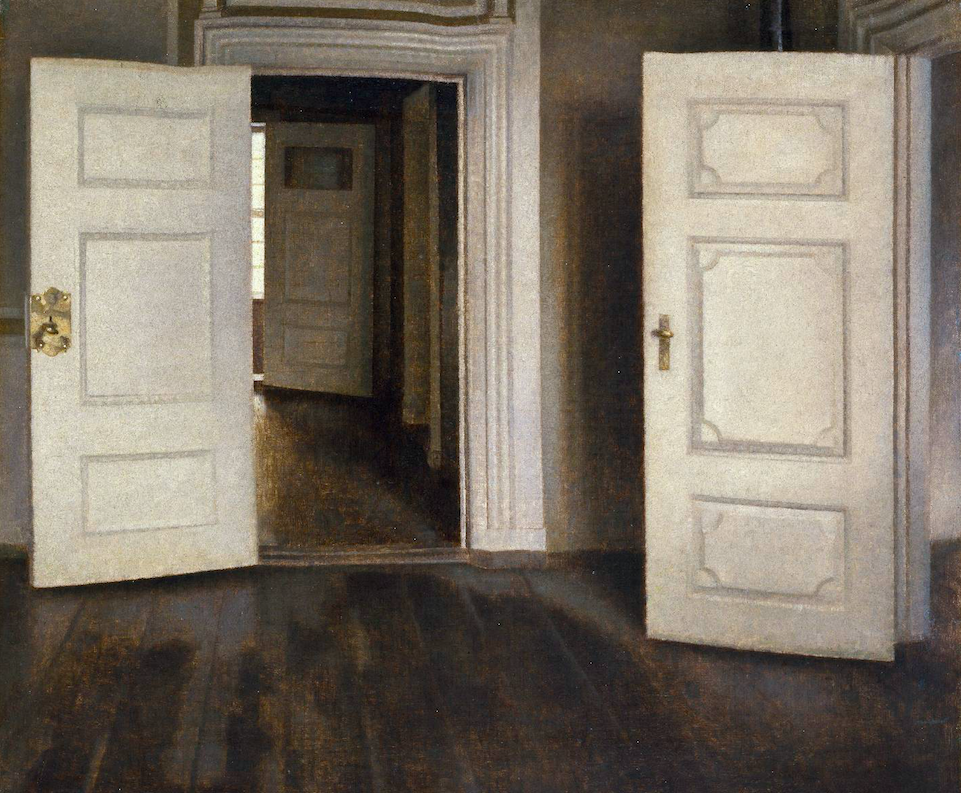Although well-known during his life time, the Danish painter Vilhelm Hammershøi (1864-1916) was largely forgotten in the decades following his death. His figurative paintings of meditative interiors were at odds with many of the more radical artistic movements of the 20th century, and the development of his practice outside of art history’s successive “-isms” meant that he was eclipsed from traditional accounts of the evolution of Modern art. It wasn’t until the 1990s that a travelling retrospective at the Ordrupgaard in Copenhagen, Musée d’Orsay in Paris and then Guggenheim in New York brought the painter back into public view. Over the last decade, a series of exhibitions from London to Tokyo has led to a significant revival of interest in the artist, as well as to multi-million-dollar sales of his paintings at auction.
The Japanese, it seems, are among Hammershøi’s greatest admirers. In 2008, the artist’s first retrospective in Japan, “Vilhelm Hammershøi: The Poetry of Silence” at the National Museum of Western Art in Tokyo, was a resounding success, and now a new exhibition, opening on January 21 at the Tokyo Metropolitan Art Museum, will present a comprehensive survey of nearly 40 works by the artist, alongside paintings by other key figures in 19th-century Danish painting: Christen Købke, Viggo Johansen and Peder Severin Krøyer, among others.
Hammershøi was heralded as the great artist of silence; his paintings draw the viewer in with their muted tones and subdued elegance. In his depictions of clutter-less rooms and streets emptied of people, the hustle and bustle of daily life is swept aside and time appears suspended. This timeless quality might help explain his enduring appeal today, but the enigma surrounding Hammershøi, his life and his work, no doubt plays an equally important role.
Like his paintings, the artist was notoriously private; he gave very few interviews during his lifetime and after his death left little behind to help elucidate his work or influences. By all accounts he wasn’t much of a conversationalist. When the Austrian poet Rainer Marie Rilke (1875-1926) travelled to Copenhagen to meet the painter for a planned book, he quickly abandoned his project on the artist he had so admired from afar – Hammershøi, it turned out, had very little to say for himself.
What we do know is that Hammershøi’s style and subject matter crystallized early in his career and that, while he lived through the development of Impressionism through to Cubism and early Abstraction, the Danish painter’s work remained largely unaffected by the artistic movements around him. In light of the forthcoming exhibition in Tokyo, an intriguing question – as yet unanswered – is whether we might detect the influence of Japanese art somewhere in his practice. The importance of framing devices in Hammershøi’s compositions is unmissable, particularly in the positioning of door frames, windows and decorative moldings in his interior scenes. Some of these compositions recall Japanese prints and “ukiyo-e” which were, at the time of Hammershøi’s painting, being widely circulated in Europe – first in France and the UK but in Nordic countries shortly after. Alongside the more clichéd depictions of fans, screens and European women kitted out in kimonos, experimentation with unusual framing devices and compositions was a key characteristic of Japonism. One of the rare artists that we know to have inspired Hammershøi, James McNeill Whistler (1834-1903), was an early adopter of Japanese aesthetics, so a secondary influence via the American intermediary might be credible.
While Hammershøi and his influences remain enigmatic, the sparse interiors and inscrutable figures of his canvases invite an air of mystery, leaving room for multiple interpretations. Readings of Hammershøi’s paintings often pull in different directions: some project a melancholic air on the empty rooms devoid of human activity; others see them as comforting depictions of tranquil domesticity. The press materials for the Tokyo Metropolitan Art Museum’s exhibition suggest that its curators fall into the latter camp. The exhibition website describes Denmark as a capital of well-being, top of the UN’s World Happiness Rankings, and evokes the Danish concept of “hygge” (cozy, indoor comfort). Hanging alongside Hammershøi’s paintings will be works by other 19th-century Danish artists depicting idyllic scenes of family life, such as “A Little Girl Sewing” (1898-1902) by Peter Ilsted and Viggo Pederson’s “Sunshine in the Living Room” (1888). To my eyes, this reading of Hammershøi’s work is surprising, but this is perhaps what secures his ongoing appeal: it’s what the paintings of this famously reticent artist don’t say that allows them to be many things at once.
Article published on Blouin Artinfo.
